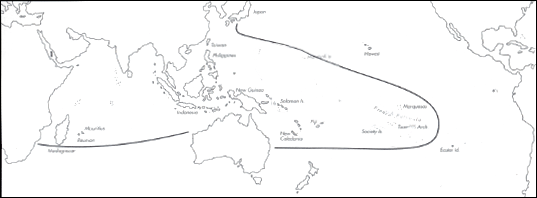
Skip Navigation Links
View access keys for this site.

Range: Indo-Pacific except for Hawaii.
Description: Moderately large to large, moderately solid to solid; relative weight may vary by 60% in specimens of the same size. Last whorl narrowly cylindrical to cylindrical; outline straight or slightly convex and nearly parallel-sided centrally, slightly concave to convex above and convex (right side) or concave (left side) below. Aperture wider at base than near shoulder. Shoulder angulate to rounded, usually strongly tuberculate. Spire low, outline variably concave to straight. Larval shell of 2.5-3 whorls, maximum diameter 0.9-1.0 mm. Postnuclear whorls tuberculate, tubercles strong and pointed upward in late whorls. Teleoconch sutural ramps concave, with 0-2 increasing to 4-5 spiral grooves in early whorls; closely set axial striae and many spiral striae produce a minutely granulose surface in later whorls. Last whorl nearly smooth except for weak spiral ribs or ribbons near base of subadults.
| Shell Morphometry | ||
|---|---|---|
| L | 65-166 mm | |
| RW | 0.10-0.80 g/mm | |
| (L 65-133 mm) | ||
| RD | 0.49-0.56 | |
| (adult; 0.45 - 0.51 subadults) | ||
| PMD | 0.62-0.75 | |
| RSH | 0.04-0.10 | |
Ground colour white, suffused with bluish grey, violet or pink. Last whorl with fine, often incomplete network of tan to dark reddish brown lines and small often tent-like spots. Pattern tends to fuse into blotches forming 2-3 broad spiral bands, within basal third, above centre and often below shoulder; occasionally, bands contain dotted, dashed or solid dark spiral lines. Larval whorls pink to red. Earliest postnuclear sutural ramps white to pink, usually with brown dots at both or only inner margins. Following sutural ramps with light to dark brown radial blotches that separate into loosely reticulated lines in late whorls. Aperture white.
Periostracum grey to yellowish or reddish brown, thin and variably translucent, with closely spaced axial ridges on sutural ramps and with spiral rows of tufts on last whorl, that are arranged in 9-11 widely spaced groups of 2-3 rows.
Animal with a broad, massive foot. Dorsum of foot white, with a broad cream to pale orange longitudinal band and overlying interlaced brown to black radial streaks and blotches laterally, solid black at posterior end; medially and anteriorly, pinkish tan spots, patches and veins form a network similar to that of the shell. Sole of foot white, mottled with light brown. Rostrum yellow brown, marbled with darker brown dorsally; indented at distal edge. Tentacles white, tipped with light brown. Siphon white, with brown to dark brown transverse stripes on lighter brown flecks; tip white (Pl. 76, Fig. 50, Pl. 81, third row, right) (Bergh, 1895; Chaberman, pers. comm., 1981; Estival,unpubl. observ.). In subadult animals from the Marshall Is., dorsum of foot greyish white, mottled with black; mottling heavy at posterior end, almost absent at anterior end (Pearson, unpubl. observ.). In the N. Red Sea, animal reddish brown, mottled with black on siphon and marginal zones of the foot's dorsum (Fainzilber et al., 1992).
Radular teeth with an adapical barb opposite a slightly barbed cutting edge; serration of about 125 denticles extends back to centre of tooth; basal knob weak, without a spur (Troschel, 1868; Bergh, 1895; Peile, 1939; Endean & Rudkin, 1965). The tooth depicted by Bandel (1984) for specimens from Port Sudan (Red Sea) has a distinct second barb rather than a slightly barbed cutting edge and its base appears to have a weak spur.
Habitat and Habits: Intertidal to about 20 m; on coral reefs, mainly on sand bottoms beneath or among coral heads, also on lagoon pinnacles, in caves and on coral rubble (Kohn, 1961b; Cernohorsky, 1964; Marsh, 1971; Sharabati, 1984; Grosch, pers. comm., 1989; Tirard, pers. comm., 1989; Fainzilber et al., 1992). C. geographus feeds on fishes, sometimes also on molluscs. It captures its prey with it’s rostrum without stinging it first; after a fish is engulfed, it may be stung. Animals with shells of 80-87 mm may feed on fishes 130- 140 mm long; fresh dead fishes may also serve as food. Venom highly toxic to fishes and mammals, known to cause fatalities in humans. Toxicity and high quantity of injected venom make C. geographus the most dangerous Conus species. It has caused more than 30 human fatalities. (Kohn, 1963, 1983; Johnson & Stablum, 1971; Cruz, Gray & Olivera, 1976, 1978; Cruz, Corpuz & Olivera, 1978; Tsuriel, 1978). Animals observed to oviposit in isolated coral heads; capsule masses may be made by several females. Capsules deposited in short rows forming an irregular cluster; each row affixed to substratum by confluent basal plates. Observed number of capsules per spawn is 54, observed number of eggs per capsule 14,500-17,800, and observed capsule size 26-28 x 18-21 mm. Egg diameter of about 190 µm predicts a minimum pelagic period of about 24 days (Kohn, 1961b; Perron & Kohn, 1985).
Discussion: C. geographus closely resembles C. eldredi and C. fragilissimus and is also similar to C. tulipa and C. obscurus; for comparison, see the Discussions of those species.

C. geographus range map
This section contains verbatim reproductions of the accounts of 316 species of Conus from the Indo-Pacific region, from Manual of the Living Conidae, by Röckel, Korn and Kohn (1995). They are reproduced with the kind permission of the present publisher, Conchbooks.
All plates and figures referred to in the text are also in Röckel, Korn & Kohn, 1995. Manual of the Living Conidae Vol. 1: Indo-Pacific Region.
The range maps have been modified so that each species account has it own map, rather than one map that showed the ranges of several species in the original work. This was necessary because each species account is on a separate page on the website and not confined to the order of accounts in the book.
Return to framed version (returns to search page)